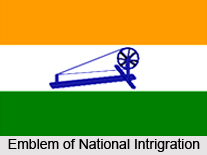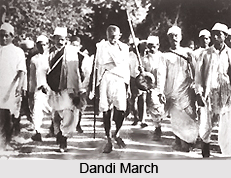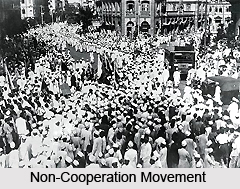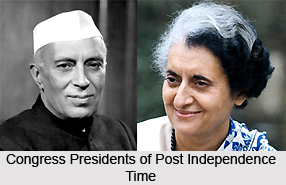 The history of the Indian National Congress falls into two distinct eras, namely the pre-independence era, when the party was at the forefront of the struggle for independence; and the post-independence era, when the party has enjoyed a prominent place in Indian politics, ruling the country for 48 of the 60 years since independence in 1947. In the pre-independence era, the Indian National Congress was divided in two groups, moderate and activist. The moderates were more educated and wanted to attract people`s faith to rule over the country and enjoy the power which British was enjoying and eventually they achieved what they were looking for.
The history of the Indian National Congress falls into two distinct eras, namely the pre-independence era, when the party was at the forefront of the struggle for independence; and the post-independence era, when the party has enjoyed a prominent place in Indian politics, ruling the country for 48 of the 60 years since independence in 1947. In the pre-independence era, the Indian National Congress was divided in two groups, moderate and activist. The moderates were more educated and wanted to attract people`s faith to rule over the country and enjoy the power which British was enjoying and eventually they achieved what they were looking for.
Indian National Congress was founded in 1885 with the objective of obtaining a greater share in government for educated Indians; the principles of Indian National Congress were initially not opposed to British rule. The Congress meetings were conducted once a year during December. A Scotsman, Allan Octavian Hume brought about its first meeting in Bombay, with the approval of Lord Dufferin, the then-Viceroy. Womesh Chandra Bannerjee was the first President of the Indian National Congress. The first meeting was planned to be held in Pune, but due to a severe plague outbreak there, the meeting of Indian National Congress was later shifted to Bombay. The first Session of Indian National Congress was held from 28-31 December 1885, and was attended by 72 delegates. With passing years, the demands of Indian National Congress became more fundamental in the face of constant opposition from the government and the party became active in the independence movement. By 1907 the party was separated into two halves, namely the Garam Dal of Bal Gangadhar Tilak, or Extremists (literally "hot faction"), and the Naram Dal of Gopal Krishna Gokhale, or Moderates (literally "soft faction"), identified by their attitude towards the British. Under the influence of Bal Gangadhar Tilak, the Congress became the first integrated mass organization in the country, bringing together millions of people against the British. The Indian National Congress was the only political party to provide harmony to all the sections of the Indian society.
In its time as the nation`s leader in the freedom struggle, Indian National Congress boasted the nation`s greatest leaders. Before the Gandhi Era came leaders like Bal Gangadhar Tilak, Lala Lajpat Rai, Bipin Chandra Pal, Gopal Krishna Gokhale, Mohammed Ali Jinnah (later leader of the Muslim League and instrumental in the creation of Pakistan), all starting with the initial legendary icon of Indians. The Congress was transformed into a mass movement by Surendranath Banerjea and Sir Henry Cotton during the division of Bengal in 1905 and the resultant Swadesi Movement. Mahatma Gandhi came back from South Africa in 1915 and with the help of the pro-British group led by Ghokhale he through an extraordinary rebellion became the President of The Congress without any election and formed an alliance with the Khilafat Movement. In protest a number of leaders went out of Congress. Khilafat movement ended up in a disaster and the Congress was split. A number of leaders Chittaranjan Das, Annie Besant, Motilal Nehru, went out of the Congress to set up the Swaraj Party.
 With the rise of Mahatma Gandhi`s popularity and his Satyagraha, the art of revolution came with leaders of Indian National Congress, namely Sardar Vallabhbhai Patel, Pandit Jawaharlal Nehru (the nation`s first Prime Minister), Dr. Rajendra Prasad (the nation`s first President), Khan Mohammad Abbas Khan, Khan Abdul Ghaffar Khan, Chakravarti Rajgopalachari, Jivatram Kripalani and Maulana Abul Kalam Azad. With the already existing nationalistic feeling combined with Gandhi`s popularity the Indian National Congress became a forceful mass organization in the country, bringing together millions of people by specifically working against caste differences, untouchability, poverty, and religious and ethnic boundaries. Indian National Congress had members from virtually every religion, ethnic group, economic class and linguistic group, although majority was Hindus.
With the rise of Mahatma Gandhi`s popularity and his Satyagraha, the art of revolution came with leaders of Indian National Congress, namely Sardar Vallabhbhai Patel, Pandit Jawaharlal Nehru (the nation`s first Prime Minister), Dr. Rajendra Prasad (the nation`s first President), Khan Mohammad Abbas Khan, Khan Abdul Ghaffar Khan, Chakravarti Rajgopalachari, Jivatram Kripalani and Maulana Abul Kalam Azad. With the already existing nationalistic feeling combined with Gandhi`s popularity the Indian National Congress became a forceful mass organization in the country, bringing together millions of people by specifically working against caste differences, untouchability, poverty, and religious and ethnic boundaries. Indian National Congress had members from virtually every religion, ethnic group, economic class and linguistic group, although majority was Hindus.
In 1939, Subhas Chandra Bose, the elected president in both 1938 and 1939 was expelled from the Congress for his socialist views and The Congress was reduced to a pro-Business group financed by the business houses of Birla and Bajaj. At the time of the Quit India movement, the Congress was undoubtedly the strongest political and revolutionary organization in India, but the Congress separated itself from the Quit India movement within a few days. The Indian National Congress could not claim to be the true representative of the Indian people as other parties were there as well particularly the Hindu Mahasabha, Azad Hind Sarkar and Forward Bloc.
The 1929 Lahore session of Indian National Congress under the presidency of Jawaharlal Nehru holds special significance in the history of Indian National Congress. In this session "Poorna Swaraj" (complete independence) was declared as the goal of INC. The 26th January 1930 was declared as "Poorna Swaraj Diwas," Independence Day although the British remained in India a number of years longer. It was to commemorate this date particularly that The Indian Constitution was formally adopted on 26 January 1950 (even though it was passed on 26 November 1949). However in 1929 Srinivas Iyenger was barred from the Congress for demanding full independence, not just home rule as demanded by Gandhi.
After the First World War the party became associated with Mahatma Gandhi, who remained its unofficial, devout leader and mass image even as younger men and women became party president. The party was in many ways an umbrella organization, sheltering within itself radical socialists, traditionalists and even Hindu and Muslim conservatives, but all the socialists (including the Krishak Praja Party, Congress Socialist Party, Swarajya Party members) were excluded along with Subhas Chandra Bose in 1939 by Mahatma Gandhi.

During the INA trials of 1946, the Indian National Congress helped to form the INA Defence Committee, which compellingly defended the case of the soldiers of the Azad Hind government. The committee confirmed the formation of the Congress` defence team for the INA and included famous lawyers of the time, including Bhulabhai Desai, Asaf Ali and Jawaharlal Nehru. Members of the Congress initially supported the sailors who led the Royal Indian Navy Mutiny. However they withdrew support at the critical moment, when the mutiny failed.
During the Post-Independence Era, Indian National Congress remained in power for thirty continuous years between independence in 1947 and its first taste of electoral defeat (at the national level) in 1977. Mahatma Gandhi and Sardar Patel are said to have witnessed that Indian National Congress was formed only for achieving independence and should have been disbanded in 1947. However, at the time of independence, the Indian National Congress (led by Jawaharlal Nehru) was a major political organisation in the nation and was established as the major political party. Indian National Congress have thus provided leadership and guiding vision after the terrible chaos and confusion following the Partition of India and Independence, was re-established as an electoral party in independent India. Across several general elections, the party ruled unremitting until 1977, and has remained a major political force.
After the murder of Gandhi in 1948, and the death of Sardar Patel in 1950, Jawaharlal Nehru was the only remaining iconic national leader, and soon the situation demanded Nehru to be the key to the political potency and future of the Congress. Nehru embraced secularism, socialist economic policies and a non-aligned foreign policy, which became the characteristic of the modern Congress Party. Nehru`s policies challenged the peasantry class, the business class and improved the position of religious minorities and lower caste Hindus. A generation of freedom fighting leaders was soon replaced by a generation of people who had grown up under the guidance of Nehru. Nehru led the Indian National Congress to consecutively majorities in the elections of 1952, 1957 and 1962.
After Nehru`s death in 1964, the party`s future initially came into question. No leader was competitive enough to touch Nehru`s iconic status, so the second-stage leadership mustered around the compromise candidate, the gentle, soft-spoken and Nehruvian Lal Bahadur Shastri. Shastri remained Prime Minister till his own death in 1966, and a broad Congress Party election choose Indira Gandhi, Nehru`s daughter, over the right wing, conservative Morarji Desai.
 The first serious challenge to Congress supremacy came in 1967 when a united opposition, under the banner of Samyukt Vidhayak Dal, won control over several states in the Hindi strap. The majority of the party leadership then challenged Indira Gandhi, the daughter of Nehru, and Congress president. The conflict led to a division, and Indira launched a separate Indian National Congress. Initially this party was known as Congress (R), but it soon came to be commonly known as the New Congress. The official party became known as Indian National Congress (Organisation) led by Kamaraj. It was informally called the Old Congress. As Indira Priyadarshini gained control over the state machinery, the Election Commission of India recognized her faction as the "real" INC, although her organization was the breakaway group.
The first serious challenge to Congress supremacy came in 1967 when a united opposition, under the banner of Samyukt Vidhayak Dal, won control over several states in the Hindi strap. The majority of the party leadership then challenged Indira Gandhi, the daughter of Nehru, and Congress president. The conflict led to a division, and Indira launched a separate Indian National Congress. Initially this party was known as Congress (R), but it soon came to be commonly known as the New Congress. The official party became known as Indian National Congress (Organisation) led by Kamaraj. It was informally called the Old Congress. As Indira Priyadarshini gained control over the state machinery, the Election Commission of India recognized her faction as the "real" INC, although her organization was the breakaway group.
The separation can in some ways be seen as a left wing or right-wing division. Indira Gandhi wanted to use a populist agenda in order to mobilize popular support for the party. She initiated slogans such as Garibi Hatao (Remove Poverty), and wanted to develop closer ties with the Soviet Union. The regional party elites, who formed the INC(O), stood for a more conservative schedule, and distrusted Soviet help. INC(O) later merged into the Janata Party. Gradually, Indira Gandhi grew more and more authoritarian. Facing growing opposition she proclaimed a state of National Emergency in 1975, condensed the powers of the courts, and unleashed a police state.
After she lifted the emergency in 1977, more Indian National Congress divisions were formed, the one remaining loyal to Indira Gandhi being popularly known as Congress (I) with an `I` for Indira. The Congress (I) was routed in the general elections by the Janata Party, but the federation government fell apart in two years. The Congress party returned to power in the resulting 1980 elections. In 1984 Indira Gandhi was assassinated by two of her Sikh bodyguards, in revenge for Operation Blue Star. In the following days activists and leaders of the Congress Party killed more than six thousand Sikhs in the 1984 riots, mainly in Delhi. On the other hand militants seeking a separate homeland slaughtered three thousand to eight thousand Hindus in the Punjab from 1984 to 1991.
After Indira, her son Rajiv Gandhi took over as Congress leader and led the party to victory with a large majority in the 1984 Lok Sabha elections. It was into the government from 1984-9 and then was defeated in the 1989 general election. Rajiv Gandhi was also assassinated by the LTTE during the course of the election campaign in 1991. Following Rajiv Gandhi`s assassination, P.V. Narasimha Rao succeeded him as Congress leader and became prime minister. The 1990s was a period of prolonged crisis for the Congress. With passing years, the party asked the Rajiv Gandhi`s widow, Sonia, to accept the position of Congress President. She refused at the time, and the Congress stuck with Narasimha Rao. Rao considerably changed the party`s traditionally socialist policies and introduced major economic reforms and liberalization, with the help of then Finance minister (and future Prime Minister) Manmohan Singh. Nonetheless, his involvement in the bribery of members of parliament was a major issue, which led to the downfall of the Congress in 1996, and subsequently his fall out with other leaders in his own party and eventual exit from politics. Former treasurer Sitaram Kesri took over the reins of the party and oversaw the Congress support to the United Front governments that ran from 1996 - 1998.
 During his tenure, several key leaders broke away from the party, and serious infighting broke out among those left. In 1998, Sonia Gandhi finally accepted the post of Congress President, with a thought that may have saved the party from extinction. After her election as party leader, a section of the party, which objected to the choice, broke away and formed the Nationalist Congress Party. The use of "Congress (I)" continues to denote the party run by Indira Gandhi`s successors. Although the Congress expedited the downfall of the NDA government in 1999 by promising an alternative, Ms. Gandhi`s decision was followed by fresh elections and the Congress party`s worst-ever tally in the lower house. The party spent the interval period creating alliances and overseeing changes in the state and central organizations to revive the party.
During his tenure, several key leaders broke away from the party, and serious infighting broke out among those left. In 1998, Sonia Gandhi finally accepted the post of Congress President, with a thought that may have saved the party from extinction. After her election as party leader, a section of the party, which objected to the choice, broke away and formed the Nationalist Congress Party. The use of "Congress (I)" continues to denote the party run by Indira Gandhi`s successors. Although the Congress expedited the downfall of the NDA government in 1999 by promising an alternative, Ms. Gandhi`s decision was followed by fresh elections and the Congress party`s worst-ever tally in the lower house. The party spent the interval period creating alliances and overseeing changes in the state and central organizations to revive the party.
In the 2004 general elections, the Congress coalition won the largest number of seats and got an assurance of support from the Left Front upsetting the Atal Behari Vajpayee, led National Democratic Alliance, which was variously predicted to win complete victory or at least emerge as the largest alliance. Shortly thereafter, Sonia Gandhi was nominated by the Congress-led United Progressive Alliance to be the next Prime Minister. Sonia Gandhi refused to take the position based on her "inner voice" and she promoted the eminent economist, former Union Finance Minister and senior Congress leader Dr. Manmohan Singh for the post of Prime Minister, and he was sworn-in as Prime Minister on 22 May 2004.
The list of Indian Prime Ministers from the Congress Party is as follows -
•Jawaharlal Nehru (1947 - 1964)
•Gulzarilal Nanda (May - June 1964, January 1966)
•Lal Bahadur Shastri (1964 - 1966)
•Indira Gandhi (1966 - 1977, 1980 - 1984)
•Rajiv Gandhi (1984 - 1989)
•P.V. Narasimha Rao (1991 - 1996)
•Manmohan Singh (2004 - present)




















